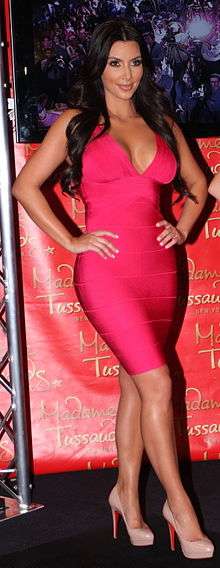Foundation garment
A foundation garment (also known as shapewear or shaping underwear) is an undergarment designed to impermanently alter the wearer's body shape, to achieve what some view as a more fashionable figure. The function of a foundation garment is not to enhance a bodily feature (as would, for example, a padded bra) but to make it look more presentable.

Specific styles of foundation garments have been essential to some fashion movements, and were required in some social situations during various fashion periods.
Overview
Women have worn foundation garments, such as corsets and brassieres, for a very long time.[1] Some have been essential to the fashion trends of the time. Others have been born out of the need for women to feel more secure.
The industry continues to grow each year. Debenhams recorded a 75% increase in shapewear sales between 2009 and 2013.[2] The contributing factors include fashions that emphasize body shape; technological advances in garment design and light-weight fabrics; re-branding of pantie girdles as panties; media items about celebrities wearing shapewear; and recommendations in fashion makeover television programmes and the media. A survey of 500 American women carried out by Kelton Research for Jockey International in 2008 showed that 44% wore shapewear regularly or occasionally. Traditional brands are favoured by the mature market; of two hundred and seventy reviews of best-selling Marks and Spencer control briefs, 73% of respondents were over 55, and just 5% of two hundred and thirty HerRoom control briefs reviews were from women under fifty; this proportion increased to over one third in the case of a firm long leg girdle.
Types of foundation garment
Garments may be categorized according to level or shape control offered, for instance, light, medium or firm. The simplest foundation is a body-liner or bodysuit, which is an ultra-light-weight leotard and offers a light touch of smoothing. These are available in a unitard style (shortened legs) or a camisole-leotard style. The leotard is better and is available in boy-leg and Capri-leg lengths, with spaghetti straps, low cut necklines, and even scoop backs, to cater to the outerwear under which the garments will be worn. These softly smooth the figure and provide light support. Micro-fiber camisoles and boy-leg briefs or "hot pants" are also available. Girdles are often called "body shapers" or "contour garments". These garments are made with more Lycra spandex as compared to the 10% Lycra / 90% cotton blend of most leotards, and they offer the highest level of shaping and support.
Fashion considerations
A foundation garment may be worn for a specific outfit. Being underwear, the foundation garment should not be visible under the outerwear. A general purpose "all the way" shaper with clear straps that starts at the bust and ends at the knee or mid-calf is also available.
Foundation garments may come with a built-in strapless bra for dresses and halters.
References
- Valerie Steele, The Corset: a cultural history, Yale University Press, 2001, ISBN 0-300-09071-4.
- Irish Examiner, 18 August 2013